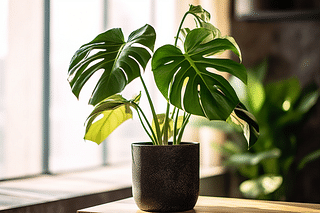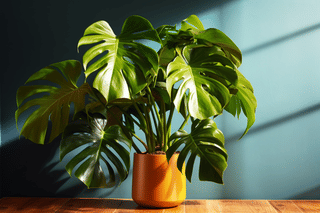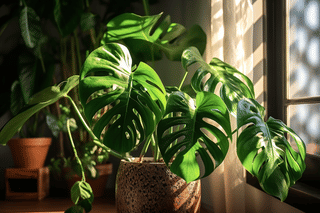Overwatered vs Underwatered Monstera: Signs, Symptoms, and Solutions
Are you struggling to keep your Monstera healthy? This comprehensive guide covers all the signs and symptoms of overwatering and underwatering, and the best solutions to help your plant thrive. Read on to become a Monstera pro and watch your plant flourish!
 As a plant enthusiast, I've come to learn that watering your plants is a crucial aspect of their care routine. However, it's not just about watering them regularly, but also about providing them with the right amount of water.
As a plant enthusiast, I've come to learn that watering your plants is a crucial aspect of their care routine. However, it's not just about watering them regularly, but also about providing them with the right amount of water.
Overwatering and underwatering are two common mistakes that plant owners make, and it can have a significant impact on the health of your plants. In this plant care guide, I will be discussing the differences between overwatered and underwatered Monstera plants and how to identify and prevent these issues.
Let's learn a little bit more about the Monstera and how we can recognize the signs of whether your Monstera is underwatered or overwatered.
Understanding Monstera Deliciosa
Before we look at the different symptoms your Monstera might show you when it's not happy with its watering schedule, let's quickly look at the Monstera itself. By looking at the plant's natural habitat and appearance, we can learn a little more about the watering schedule that's ideal for it.
Origin and Habitat
The Monstera Deliciosa is native to the tropical rainforests of Central and South America and is commonly known as the Swiss cheese plant. It belongs to the Araceae family and is a climbing plant that can grow up to 20 meters in height. In its natural habitat, Monstera Deliciosa grows on the forest floor and climbs up trees to reach sunlight.
Physical Characteristics
The Monstera's leaves are large, heart-shaped, and glossy. The plant's stem is thick and sturdy, and it has aerial roots that help it climb up trees.
The holes in the leaves of Monstera Deliciosa are called fenestrations. These fenestrations allow the plant to regulate the amount of sunlight it receives. In its natural habitat, the plant receives dappled sunlight, and the holes in the leaves help it to filter out excess light.
So what does this have to do with watering your monstera? The natural habitat shows that this plant thrives in moist soil, the thick stems tell you that the Monstera stores quite a bit of moisture, so it can survive if you forget to water it for a few days, and its large leaves help to "sweat out" excess moisture if you've accidentally watered it a little too much.
So your Monstera is already quite good at regulating how much water it needs, but if you consistently water it too much or too little, your plant starts to struggle. Let's see how!
Signs of Overwatering in Monstera
As we've already seen in the previous section, the Monstera can deal with you accidentally watering it a little too much from time to time. However, if you consistently water your plant too much, it will start to suffer. Let's find out how your Monstera shows you it's not happy.
Sweating leaves
The first sign that your monstera has gotten too much water is the little water drops at the tips of your Monstera's leaves. The Monstera will attempt to "sweat out" the excess moisture it is getting and this looks like small drops of water on the tips of its leaves.
These drops of water don't automatically mean your plant is in trouble, but it does tell you that you should water your Monstera a little less often or use a little less water.
Root Rot
When you don't pick up on the sweating leaves and continue to water your Monstera too much, root rot will start to develop on your Monstera. When the soil is too wet, the roots start to rot, and the plant is not able to absorb nutrients properly. This can lead to stunted growth, yellowing leaves, and even death of the plant. If the roots are brown and mushy, it's a sign of root rot.
Yellowing Leaves
A clear sign your Monstera is suffering from root rot is the yellowing of its leaves. When the soil is too wet, the roots can't absorb oxygen properly, leading to root rot. As a result, the leaves start to turn yellow, starting from the bottom of the plant and moving upwards.
Leaf Drop
Overwatering can also cause leaves to drop off your Monstera. When the roots can't absorb oxygen properly, the plant starts to shed leaves to conserve energy. This is a survival mechanism, and it's the plant's way of telling us that something is wrong.
These were the signs that your plant might be overwatered. Have you not seen any of these symptoms on your Monstera? Then your Monstera might be too dry. Let's see what your Monstera might show you when it needs more water.
Signs of Underwatering in Monstera
If you've looked at the symptoms of an overwatered monstera and you didn't recognize any of the signs on your plant, it might need more water. Let's see which symptoms your Monstera might show you if it's too dry.
Brown and Crispy Edges
One of the most common signs of underwatering in Monstera is the appearance of brown and crispy edges on the leaves. This happens because the plant is not receiving enough water to support its growth, so the edges of the leaves start to dry out and turn brown. If you notice this happening to your Monstera, it's important to water it more frequently to prevent further damage.
Slow Growth
Another sign of underwatering in Monstera is slow growth. When the plant is not getting enough water, it can't absorb the nutrients it needs to grow properly. This can result in stunted growth and smaller leaves. If you notice that your Monstera is not growing as quickly as it should be, it may be a sign that it needs more water.
Wilting Leaves
Wilting leaves are another sign of underwatering in Monstera. When the plant is not getting enough water, the leaves will start to wilt and droop. This is because they are not receiving enough water to stay filled and upright. If you notice your Monstera leaves wilting, it's important to water your plant immediately to prevent further damage.
Have you seen any of these symptoms on your Monstera? Make sure to water it a little more often and see if it starts to grow more quickly again. If it is, make sure to check on the new leaves and make sure there aren't any crispy brown edges forming.
Comparing Overwatered and Underwatered Monstera
When it comes to watering a Monstera, striking the right balance between watering and drying out is crucial. Both overwatering and underwatering can lead to problems and affect the plant's overall health. In this section, I will compare overwatered and underwatered Monstera and highlight the differences between them.
Overwatered Monstera
Overwatering Monstera can lead to root rot, which can be deadly for the plant. When the soil is constantly wet, the roots cannot get enough oxygen, and they start to rot. Some signs of overwatering include:
- Yellowing leaves
- Wilting leaves
- Moldy or mushy soil
- Foul smell coming from the soil
If you notice any of these signs, it's essential to stop watering the plant immediately and let the soil dry out. You may also need to repot the plant in fresh, well-draining soil.
Underwatered Monstera
Underwatering Monstera can cause the leaves to wilt and turn brown. The plant may also stop growing and become stunted. Some signs of underwatering include:
- Dry, crispy leaves
- Brown tips or edges on the leaves
- Slow growth
- Drooping stems
If you notice any of these signs, it's essential to water the plant thoroughly and ensure that the soil is evenly moist. You may also need to increase the frequency of watering or adjust the amount of water you give the plant.
Finding the right balance between overwatering and underwatering is crucial for the health of your Monstera. By understanding the signs of overwatering and underwatering, you can adjust your watering routine to keep your plant healthy and thriving.
Reviving an Overwatered or Underwatered Monstera

So you've found out you've watered your Monstera too much or too little, but now what? Let's find out how you can best help your Monstera recover from being too wet or too dry.
Treatment for Overwatered Monstera
If you notice that your Monstera is overwatered, the first thing you should do is stop watering it. Overwatering can cause root rot, which can be fatal for your plant. Check the soil to see if it's soggy and remove any standing water at the bottom of the pot or in the pot's saucer.
If the soil is too wet, you will need to let it dry out before watering again. You can also repot your Monstera in fresh, well-draining soil to help it recover.
In addition to adjusting your watering schedule, you can also try the following treatments to revive an overwatered Monstera:
- Prune away any yellow or brown leaves to encourage new growth.
- Use a fungicide to prevent or treat any fungal infections caused by excess moisture.
Treatment for Underwatered Monstera
If your Monstera is underwatered, it may have wilted leaves and dry soil. The first thing to do is to water it thoroughly and make sure the soil is moist but not soggy. You can also mist the leaves with water to increase humidity levels around the plant.
To help your Monstera recover from underwatering, try the following treatments:
- Fertilize your plant with a balanced fertilizer to encourage new growth.
- Prune away any dead or damaged leaves to redirect energy to healthy parts of the plant.
Preventing Overwatering and Underwatering
If you made it this far, you've discovered whether your Monstera is overwatered or underwatered and you've taken a few steps to help your plant recover from being too wet or too dry. Now we're going to look at how to prevent getting into this situation in the future.
Correct Watering Techniques
Overwatering and underwatering are the two most common mistakes that cause your plant to struggle. To avoid these issues, following the correct watering techniques is crucial.
One technique I use is to check the soil moisture level before watering. I stick my finger about an inch into the soil to feel for moisture. If the soil feels dry, it's time to water. If the soil feels moist, I wait a few more days before checking again.
Another technique that has worked for me is to water the plant thoroughly, but not excessively. I pour water onto the soil until it starts to drain out the bottom of the pot. This ensures that the roots are getting enough water without drowning them. When the water drains from the drainage hole, let it drain for 5-10 minutes and you'll have perfectly watered your Monstera.
Importance of Well-Draining Soil
In addition to proper watering techniques, using well-draining soil is crucial to prevent overwatering. When the soil is too dense and doesn't allow for proper drainage, water can accumulate in the pot, leading to root rot.
To ensure proper drainage, I use a soil mix that contains plenty of perlite. This material helps to create air pockets in the soil, allowing excess water to drain away from the roots. Perlite also helps to keep the soil light and airy, which improves the flow of oxygen to your Monstera's roots.
Understanding Light Requirements
Finally, understanding the plant's light requirements is crucial to prevent both overwatering and underwatering. Monstera plants require bright, indirect light to thrive. If the plant is not getting enough light, it will not use up as much water, leading to overwatering.
On the other hand, if the plant is getting too much direct sunlight, it may dry out too quickly, leading to underwatering. I have found that placing my Monstera near a window that gets bright, indirect light for most of the day has worked well for maintaining the right moisture level.
By following these techniques and understanding the plant's needs, I have been able to prevent both overwatering and underwatering in my Monstera plant and I hope it does for you too!
Thank you for reading this post! I hope it helps you to keep your plants healthy and beautiful! If you're looking for more guides on specific plants, you can always request a plant guide to get a guide for the plant you have trouble with.
Test your plant care knowledge
Quiz completed!
Want to learn more? Sign up for my newsletter to receive free tips in your inbox!
Sign up now!













